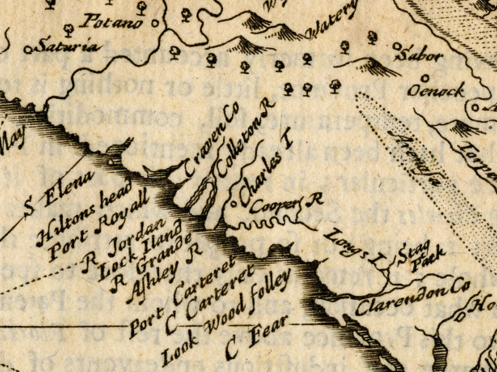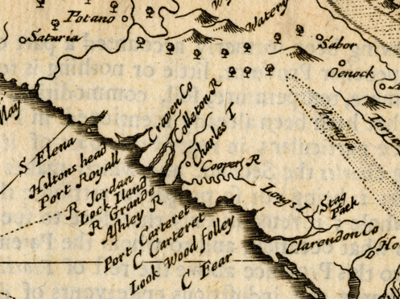In the South Carolina Encyclopedia, Charles Lesser notes that Joseph West’s time as governor of the Carolina colony was “crucial to the survival of the settlement.” He also tells us that there is not much known about West until his military service in the West Indies during the Second Anglo-Dutch War. In that conflict, from 1667 to 1668, West served under Captain James Carteret, who was a son of one of the first eight Lords Proprietors of Carolina.
When a small group of colonists set sail from England to settle Carolina in August of 1669, West was their captain. There were three ships in the fleet – the Carolina, the Port Royal, and the Albemarle. The proprietors appointed Sir John Yeamans, a Barbadian who had previously been to the area around Cape Fear, to serve as governor or to appoint someone in his place. After forty days at sea, the fleet reached Barbados, but one of the three original ships was destroyed. Yeamans leased another ship and joined the journey. But when the fleet stopped in Bermuda, Yeamans decided to return to Barbados and appointed William Sayle, who was nearly eighty at the time, governor.

Gallery One of the SCHS Museum
The plat is displayed in Gallery One of the Museum, which showcases the early European settlement of South Carolina. The gallery also features interactive kiosks examining the experiences of key figures such as Rene Ravenel, Priscilla Ball, the Cassique of Kiawah, and Eliza Lucas Pinckney.
Image: Courtesy of the South Carolina Historical Society
The group of about 150 people eventually settled Charles Town, on the banks of the Ashley River in April 1670. West had been appointed agent and storekeeper for the proprietors and was also a member of the Executive Council. Sayle’s health deteriorated quickly and before he died, he nominated West as his successor. West served as acting governor until Yeamans arrived in the colony and, in April 1672, the proprietors appointed Yeamans governor. According to Walter Edgar in South Carolina: A History, “in doing so, they replaced an able, experienced administrator with a man who was more interested in furthering his own interests than those of the proprietors.”
But Yeamans passed away in August 1674, and West was again acting governor. This time, the proprietors sent a commission, which formally named him the governor. During the first two decades of the colony, West served as governor for ten years. By all accounts, he was a careful and wise leader. He oversaw deeds of transfer for lands from the Indians, regulated the militia, and supported passage of acts “to suppress idleness, drunkenness, and profanity.” He encouraged the settlers to grow subsistence crops but also worked to meet the expectations of the proprietors, who directed him to experiment with seeds and plants that might create a profitable export.
Lesser tells us that, while practical, West was “both worldly and religious.” His wife joined him in Carolina in 1671 and in 1680 he received a grant for 1,500 acres on Biggin Creek, a branch of the Cooper River. This grant is documented by a beautiful plat that now hangs in the South Carolina Historical Society’s Museum on meeting Street. Maurice Matthew surveyed the property and executed the plat, which features a crest and drawings of native flora and fauna. West later sold that property to James Le Bas, a prominent Huguenot.

Joseph West Plat
Executed by surveyor Maurice Matthew, this plat shows property near the Cooper River that was granted to Joseph West by the Lords Proprietors. It now hangs in the South Carolina Historical Society Museum on Meeting Street in Charleston.
Image: Courtesy of the South Carolina Historical Society
In 1681 West was granted 130 acres on Charles Town Neck. In 1682, he received another grant for a town lot in Charles Town. By 1685 he owned twelve slaves and over 1600 acres. That year he fell ill and moved to Boston in the hope of improving his health. He returned to South Carolina for nearly a year and, during that time, sold most of his property in the colony. West died in New York City in 1691 and left most of his wealth to the Quaker poor in London. According to Lesser, upon West’s death, his slave Will was freed and given “such cloathing and Apparell of mine as my Executor shall think fit.”
Brought to you by the South Carolina Historical Society












